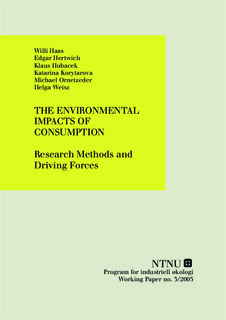| dc.description.abstract | The aim of this study is to develop an operational method to determine the direct and indirect environmental impacts of Austrian household's consumption pattern and to apply this method together with social research methods to evaluate the household's consumption pattern of two different settlements. The operational method is set up on the Household Environmental Impact (HEI) assessment based on household interviews, and without conducting a full consumer expenditure survey.
The empirical research is designed as a case-control study of the car free settlement in Vienna and aims to evaluate how the consumption patterns of the inhabitants differ from a 'control group', what impact that has on the environment taking the income (or 'rebound') effect into account, and how the attitudes and social determinants of behaviour differ between the two groups. The environmental profile of the households is calculated by using consumer expenditure surveys, information from the national accounting tables (with environmental accounts), from product life cycle assessment, and data from the conducted survey. Survey research on the motivations, preferences, and social factors is used to evaluate the driving forces and social dynamics that determine the environmental profiles of the selected households.
Residents in the car-free settlement have changed their daily mobility routines for good. Daily mobility needs are coverd by public transport and by bicycle. The high importance of the issue “car-use” in the car-free settlement, the fact that car mobility is still a very important topic in the settlement, and the environmentally conscious microculture in the car-free settlement contributes to the stabilization of the car-free habit of the tenants. Due to that only people with low car mileage state adequate attitutes, and do have much more car-free friends.
Whereas the extremely low car traffic in the car-free settlement could be partly explained by settlement attributes, there is no empirical indication to explain air traffic. The results show that car-free households have substantially lower environmental impacts in the categories of ground transportation and energy use; their CO2 emissions of these two categories are less than 50% of those of the reference settlement. The carfree households have somewhat higher emissions in the categories air transport, nutrition, and ‘other’ consumption, reflecting the slightly higher income per-capita. As a result, the CO2 emissions are only slightly lower than in the reference settlement.
The research is designed to lay the foundation for policy making through providing tools to determine the environmental impacts of consumption, as well as insight into alternative consumption patterns and factors that shape those patterns. | nb_NO |
